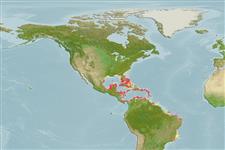Actinopterygii (ray-finned fishes) >
Perciformes (Perch-likes) >
Serranidae (Sea basses: groupers and fairy basslets) > Serraninae
Etymology: Hypoplectrus: Greek, hypo = under + Greek, plektron = sting, spur (Ref. 45335).
Environment / Climate / Range
Ecology
Marine; reef-associated; depth range 3 - 23 m (Ref. 9710), usually 3 - 17 m (Ref. 9761). Tropical, preferred ?
Western Central Atlantic: Bermuda, eastern Gulf of Mexico and throughout the Caribbean.
Size / Weight / Age
Maturity: Lm ? range ? - ? cm
Max length : 15.2 cm TL male/unsexed; (Ref. 13442)
Dorsal
spines
(total): 10;
Dorsal
soft rays
(total): 14-16;
Anal
spines: 3;
Anal
soft rays: 7. Body creamy white to pale yellow with six brown bars (the first of which runs through the eye, the second broad at nape narrowing towards the insertion of the pelvic fin, the third very wide, the fourth to sixth as wide as the second and evenly spaced behind the third bar); head and body with blue lines; pelvic fins vary in color, from white to yellowish; pectoral fins clear; caudal peduncle occasionally with a saddle (Ref. 26407).
A solitary species (Ref. 26340) inhabiting rocky and coral reefs (Ref. 9710). Always found near cover (Ref. 9710).
Life cycle and mating behavior
Maturity | Reproduction | Spawning | Eggs | Fecundity | Larvae
Domeier, M.L., 1994. Speciation in the serranid fish Hypoplectrus. Bull. Mar. Sci. 54(1):103-141. (Ref. 26407)
IUCN Red List Status (Ref. 115185)
CITES (Ref. 94142)
Not Evaluated
Threat to humans
Reports of ciguatera poisoning (Ref. 30303)
Human uses
Aquarium: commercial
More information
ReferencesAquacultureAquaculture profileStrainsGeneticsAllele frequenciesHeritabilityDiseasesProcessingMass conversion
Tools
Special reports
Download XML
Internet sources
